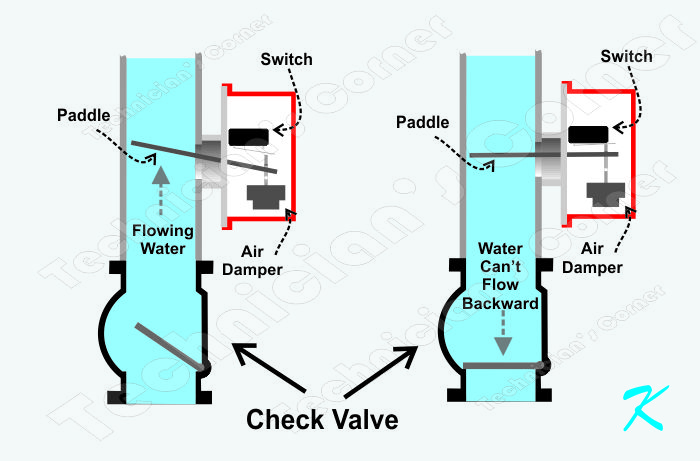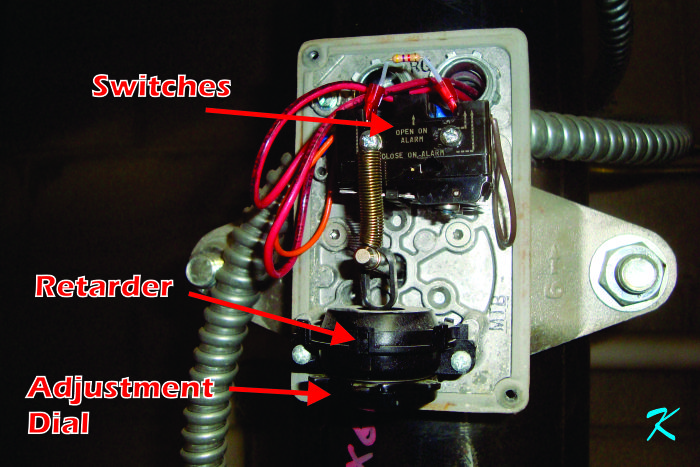There are several possible causes of the false waterflow alarms.
Waterflow Switch
A working fire alarm waterflow switch works by sensing that water is actually flowing in a sprinkler pipe.

When water is flowing in the pipe, the water is pushing a paddle aside. A lever attached to the paddle moves, and allows an air damper timer to slowly release air. Once enough air is released, then the switches activate, sending the alarm to the fire alarm panel.
Air Pressure Tank
Think of the sprinkler system, not as a series of pipe, but as a long, thin, air pressure tank. Compressed air provides the pressure, and water is what compresses the air.
When maintenance is performed on a sprinkler system, like when a sprinkler head is changed or a waterflow switch is replaced, water is let out of the sprinkler pipes. Letting water out of the pipes, though, means that air is let in.
Once the maintenance is finished, water is replaced in the pipes. The air, though, is still in the pipes; the air is just compressed into a much smaller area. In essence, the sprinkler system becomes a long, thin, air pressure tank.
It's only when more water is put into the sprinkler system that water flows. If the sprinkler system pipes were totally filled with water, no more water could flow into the pipe, so something else is happening.
In other words, if there's a very small leak in the sprinkler system, water could be forced back in through the waterflow switch.
City Water Pressure Changes
The city's water pressure regularly changes. Things like night time to day time water usage by the residents of the city, fire hydrant tests by the fire department, flushing of toilets in the building, etc. all cause the water pressure to fluctuate.
When the city's water pressure increases, water is forced into the pressure tank, or sprinkler system.
It could be that in the spring and fall, the pressure in the city's water system has greater swings, so there is a possibility it can push more water into the sprinkler system at that time.
Check Valve
When water is forced into the sprinkler system, the water flows through a check valve. The check valve is a one-way waterflow device that lets the water into the system, but doesn't let the water back into the city system.

When the check valve is working correctly, and not leaking water backwards at all, once the pressure in the sprinkler system reaches the pressure in the city's system, no water would ever be forced into the sprinkler system.
Of course, there could be a leak somewhere else, and the city could push more water past the waterflow switch, into the sprinkler system.
Drain Valve
I've seen a couple of drain valves for the sprinkler system that leaked. One leaked enough water so the false waterflow alarms occurred every night, another drain valve leaked only enough water to cause the false waterflow alarms once every two weeks.
If a drain valve, or a test valve somewhere is leaking, that could be a cause of false waterflow alarms.
Other Possible Leaks
Air is less dense than water. The air could be slowly leaking through microcracks in the sprinkler system, and as the air leaks out, water could be forced in to replace the air.
Even water could be slowly leaking out somewhere. Just not enough water to be detected in the building. This is a slim possibility.
Time Delay
Most waterflow switches have an air-based retarder as a built-in delay mechanism. This prevents the waterflow switch from acting too quickly. The delay setting for this is commonly set to :30 seconds or :45 seconds.

After a few years, the rubber diaphragm inside the retarder can dry out and reduce the time delay. I've seen where this delay has been reduced from :45 seconds to :08 seconds, sometimes less.
The delay is meant to reduce false alarms: when the delay is reduced, there are false waterflow alarms.
Check with the fire marshal to find out how much delay there should be.
Why a Particular Floor?
If the delay is too short on a particular waterflow switch, that waterflow switch is prone to be the one that goes into false alarms.
Another possibility is the sprinkler system has enough corrosion inside it so that once there's a bump in water pressure, the paddle can't return completely. It's possible, but not probable.
Still another possibility is that there's more air trapped in one floor's sprinkler pipes than the other pipes. That could also happen.
Many Possibilities
Often, the false alarms are caused by a combination of two or more problems. Each problem by itself wouldn't cause the false alarms, but when combined, they gang up and sound the alarm.
Douglas Krantz




